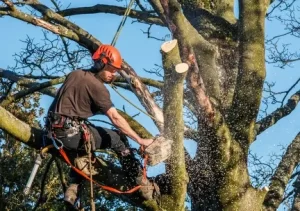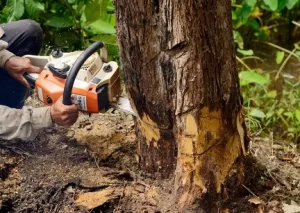Planting a new tree is an investment in your landscape that can provide beauty, shade, and environmental benefits for years to come. However, choosing the right soil for your tree is crucial to its long-term health and growth. In this blog, we’ll explore the types of soil that are best suited for various trees, and provide tips on soil preparation and maintenance. For expert tree care and planting services, visit our Home Page and Service Pages.
Understanding Soil Types
There are three main types of soil: sandy, clay, and loamy. Each has different characteristics that affect tree growth.
Sandy Soil
- Characteristics: Sandy soil is composed of large particles, which creates a loose, well-draining structure.
- Advantages: Drains quickly, prevents waterlogging.
- Disadvantages: Low nutrient retention, dries out quickly.
- Best For: Trees that prefer well-drained soil, such as pine trees and junipers.
Clay Soil
- Characteristics: Clay soil has small, tightly packed particles that retain water.
- Advantages: High nutrient retention.
- Disadvantages: Poor drainage, can become waterlogged and compacted.
- Best For: Trees that can tolerate wet conditions, such as willows and maples.
Loamy Soil
- Characteristics: Loamy soil is a balanced mix of sand, silt, and clay.
- Advantages: Good drainage, high nutrient content, and good water retention.
- Disadvantages: Can be more expensive and harder to find.
- Best For: Most trees, including fruit trees, oaks, and elms.
For more information on soil types and tree compatibility, visit our Tree Planting Services.

Testing Your Soil
Before planting a new tree, it’s important to test your soil to understand its composition and pH level. Here’s how you can do it:
- Soil Test Kit: Purchase a soil test kit from a garden center or online. Follow the instructions to collect a sample and test for pH and nutrient levels.
- Professional Testing: For more detailed results, consider sending a soil sample to a professional testing service. This can provide comprehensive information about nutrient content and soil structure.
Understanding your soil’s pH is essential because different trees thrive in different pH ranges. Most trees prefer a slightly acidic to neutral pH (6.0-7.0), but some, like blueberries, require more acidic soil (4.5-5.5).
Improving Soil Quality
If your soil is not ideal for your chosen tree, you can amend it to improve its quality:
- Adding Organic Matter: Incorporate organic matter such as compost, leaf mold, or well-rotted manure. This improves soil structure, nutrient content, and water retention.
- Adjusting pH: If your soil pH is too high (alkaline), add sulfur or peat moss to lower it. If it’s too low (acidic), add lime to raise it.
- Improving Drainage: For clay soil, add sand or gravel to improve drainage. Raised beds can also help in areas with poor drainage.
For expert advice on soil improvement, visit our Soil Amendment Services.

Tree Planting Tips
When planting a new tree, follow these tips to ensure it thrives:
- Dig the Right Hole: The hole should be twice as wide as the root ball but no deeper. This allows roots to spread out easily.
- Backfill Properly: Use the original soil mixed with compost to backfill the hole. Avoid using only compost or potting soil as this can create a barrier to root growth.
- Mulch: Apply a 2-4 inch layer of mulch around the base of the tree, but keep it away from the trunk. Mulch helps retain moisture, suppress weeds, and regulate soil temperature.
- Watering: Water the tree thoroughly after planting and continue to water regularly, especially during the first few years. Deep, infrequent watering encourages deep root growth.
For more tree planting tips, visit our Tree Care Guide.
Common Tree and Soil Pairings
Here are some common tree species and their preferred soil types:
- Oak Trees: Prefer well-drained, loamy soil but can tolerate a range of soil types.
- Maple Trees: Thrive in loamy, well-drained soil with a slightly acidic to neutral pH.
- Pine Trees: Prefer sandy, well-drained soil with a slightly acidic pH.
- Willow Trees: Tolerate wet, clayey soil and thrive near water sources.
- Fruit Trees (e.g., Apple, Pear): Prefer well-drained, loamy soil with good organic content.
Conclusion
Choosing the right soil for your new tree is crucial for its health and growth. By understanding your soil type, testing and amending it as needed, and following proper planting techniques, you can ensure your tree thrives for years to come.
For professional tree care and soil management services, visit Bieniek Tree Services. Our team of experts is dedicated to providing the best care for your trees, ensuring they remain healthy and vibrant. Visit our Home Page and Service Pages to learn more and schedule your tree care service today.
